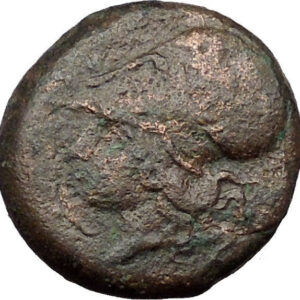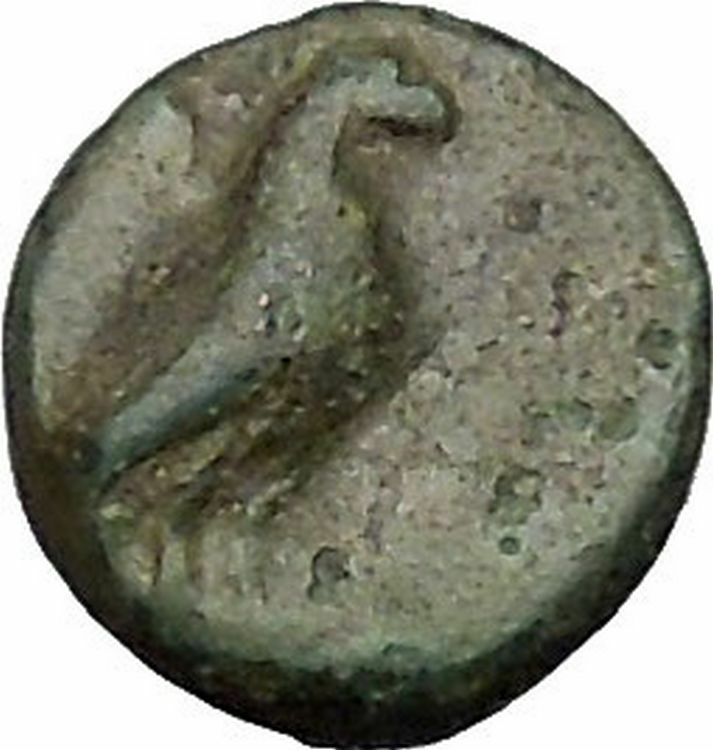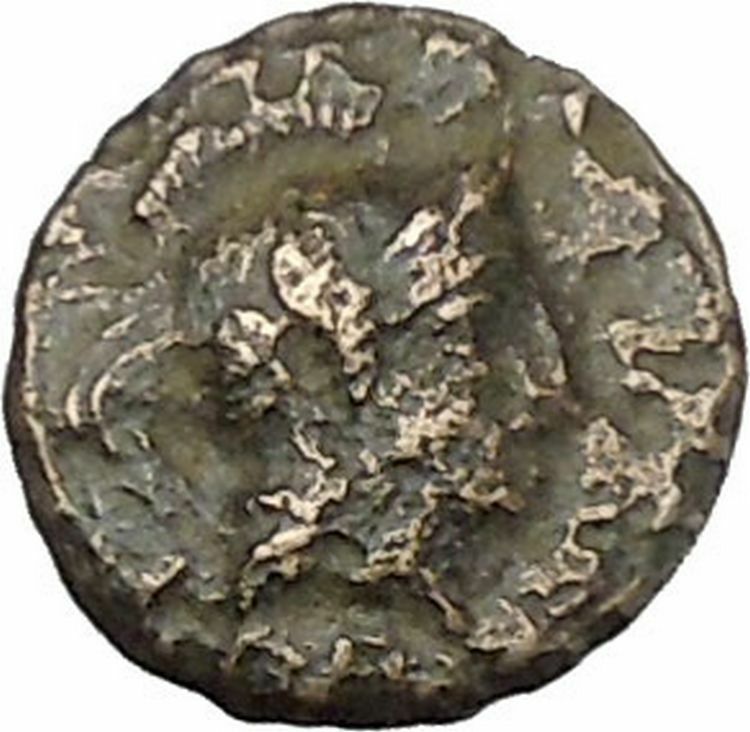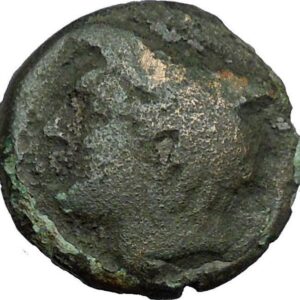|
Greek city of Termessos Major in Pisidia
Bronze 27mm (11.04 grams) Struck circa 2nd-3rd Century A.D.
TЄPMHCCЄΩN, Laureate head of Zeus right; Θ below neck.
AVTONOMΩΝ, Genius standing left, holding branch and cornucopia.
An important city of south-western Pisidia, high up in the Tauros mountains, in the pass through which the river Catarrhactes flowed. It was almost impregnable by nature and art, so that even Alexander the Great did not attempt to take it. Termessos at one time controlled a large area of territory extending into northern Lycia. Its position was given recognition by the Romans in 71 B.C. from which era its earliest coins date.
You are bidding on the exact item pictured, provided with a Certificate of Authenticity and Lifetime Guarantee of Authenticity.
The Genius was a protection spirit, analogous to the guardian angels invoked by the Church of Rome. The belief in such spirits existed in Greece and at Rome. The Greeks called them Daemons, and appear to have believed in them from the earliest times, though Homer does not mention them. Hesiod says that the Daemons were 30,000 in number, and that they dwelled on earth unseen by mortals, as the ministers of Zeus, and as the guardians of men and justice. He further conceives them to be the souls of the righteous men who lived in the golden age of the world. The Greek philosophers took up this idea, and developed a complete theory of daemons. Thus we read in Plato, that daemons are assinged to men at the moment of their birth, that they accompany men through life, and after death conduct their souls to Hades. Pindar, in several passages of the spirit watching over the fate of man from the hour of his birth. The daemons are further described as ministers and companions of the gods, who carry the prayers of men to the gods, and the gifts of the gods to men, and accordingly float in immense numbers in the space between heaven and earth. There was also a distinct class of daemons, who were exclusively the ministers of the gods.
The Romans seem to have received their notions respecting the genii from the Etruscans, though the name Genius itself is Latin (it is connected with gi-gn-o, gen-ui, and equivalent in meaning to generator or father). The genii of the Romans are the powers which produce life (dii genitales), and accompany man through it as his second or spiritual self. They were further not confined to man, but every living being, animal as well as man, and every place had its genius. Every human being at his birth obtained (sortitur) a genius, who he worshipped as sanctus et sanctissimus deus, especially on his birthday, with libations of wine, incense, and garlands of flowers. The bridal bed was sacred to the genius, on account of his connection with generation, and the bed itself was called lectus genialis. On other merry occasions, also , sacrifices were offered to the genius, and to indulge in merriment was not unfrequently expressed by genio indulgere, genium curare, or placarae. The whole body of the Roman people had its own genius, who is often seen represented on coins of Hadrian and Trajan. He was worshipped on sad as well as joyous occasions; thus, sacrifices were offered to him at the beginning of the 2nd year of the war with Hannibal. The genii are usually represented in works of art as winged beings. The genius of a place appears in the form of a serpent eating fruit placed before him.
Pisidia was a region of ancient Asia Minor located north of Lycia, and bordering Caria, Lydia, Phrygia and Pamphylia. It corresponds roughly to the modern-day province of Antalya in Turkey. Among Pisidia’s settlements were Termessus, Selge, Cremna, Sagalassos, Etenna, Antiochia, Neapolis, Tyriacum, Laodiceia Katakekaumene and Philomelium.

Amphiteatre of Termessos
Geography
Although close to Mediterranean Sea on the map, the warm climate of the south cannot pass the height of the Taurus Mountains. Owing to the climate, there is no timberland but crop plants grow in areas provided with water from the mountains, whose annual average rainfall is c. 1000 mm on the peaks and 500 mm on the slopes. This water feeds the plateau. The Pisidian cities, mostly founded on the slopes, benefited from this fertility. The irrigated soil of the land is very suitable for growing fruit and for husbandry.
History
Early history
The area of Pisidia has been inhabited since the Paleolithic age, with some settlements known from historical times ranging in age from the eighth to third millennium BC. The ancestors of the classical Pisidians were likely present in the region before the 14th century BC, when Hittite records refer to a mountain site of Salawassa, identified with the later site of Sagalassos. At that time, Pisidia appears to have been part of the region the Hittites called Arzawa. The Pisidian language is poorly known, but is assumed to be a member of the Anatolian branch of Indo-European languages.
Herodotus mentioned the Pisidic people in the text which they were called “Lakuna” but this was one of the names given to Pisidic tribes, which occupied a little mountainous region north to the Antalya Bay. Pisidians are known to be among the nations which helped the Persians in their war against Greece.
There can be little doubt that the Pisidians and Pamphylians were the same people, but the distinction between the two seems to have been established at an early period. Herodotus, who does not mention the Pisidians, enumerates the Pamphylians among the nations of Asia Minor, while Ephorus mentions them both, correctly including the one among the nations on the interior, the other among those of the coast. Pamphylia early received colonies from Greece and other lands, and from this cause, combined with the greater fertility of their territory, became more civilized than its neighbor in the interior. Pisidia remained a wild, mountainous region, and one of the most difficult for outside powers to rule.
As far back as the Hittite period, Pisidia was host to independent communities not under the Hittite yoke. Known for its warlike factions, it remained largely independent of the Lydians, and even the Persians, who conquered Anatolia in the 6th century BC, and divided the area into satrapies for greater control, were unable to cope with constant uprisings and turmoil.
Hellenistic period
Alexander the Great had somewhat better fortune, conquering Sagalassos on his way to Persia, though the city of Termessos defied him. After Alexander died, the region became part of territories of Antigonus Monophthalmus, and possibly Lysimachus of Thrace, after which Seleucus I Nicator, founder of the Seleucid Dynasty of Syria, took control of Pisidia. Under the Selucids Greek colonies were founded at strategically important places and the local people Hellenised. Even so, the Hellenistic kings were never in complete control, in part because Anatolia was contested between the Selucids, the Attalids of Pergamon, and the Galatians, invading Celts from Europe. The cities in Pisidia were among the last in western Anatolia to fully adopt Greek culture and to coin their own money.
Pisidia officially passed from the Selucids to the Attalids as a result of the Treaty of Apamea, forced on Antiochos III of Syria by the Romans in 188 BC. After Attalos III, the last king of Pergamon, bequeathed his kingdom to Rome in 133 BC as the province of Asia, Pisidia was given to the Kingdom of Cappadocia, which proved unable to govern it. The Pisidians cast their lot with pirate-dominated Cilicia and Pamphylia until Roman rule was restored in 102 BC.
In 39 BC Marcus Antonius entrusted Pisidia to the Galatian client king Amyntas and charged him with putting down the bandit Homonadesians of the Taurus Mountains, who threatened the roads connecting Pisidia to Pamphylia. After Amyntas was killed in the struggle 25 BC, Rome made Pisidia part of the new province of Galatia. The Homonadesians were finally wiped out in 3 BC.
Roman and Byzantine period
During the Roman period Pisidia was colonized the area with veterans of its legions to maintain control. For the colonists, who came from poorer parts of Italy, agriculture must have been the area’s main attraction. Under Augustus, eight colonies were established in Pisidia, and Antioch and Sagalassos became the most important urban centers. The province was gradually Latinised. Latin remained the formal language of the area until the end of the 3rd century.
Pisidia was important in the early spread of Christianity. St. Paul visited Antioch on each of his missionary journeys, helping to make it a center of the new faith in Anatolia. After the Emperor Constantine‘s legalization of Christianity in 311 it played an important role as a metropolitan city. Afterwards it became the capital city of the Christian Pisidian Province, founded in the 4th century; Parlais became its titular see. Most Pisidian cities were heavily fortified at that time due to civil wars and foreign invasions.
The area was devastated by earthquake in 518, a plague around 541-543, and another earthquake and Arab raids in the middle of the 7th century. After the Muslim conquest of Syria disrupted trade routes, the area declined in importance. In the 8th century the raids increased. In the 11th century the Seljuk Turks captured the area and founded the Seljuk Sultanate in Central Anatolia. Pisidia constantly changed hands between the Eastern Roman Empire and the Turks until 1176, when the Great Sultan Kılıçarslan defeated Manuel Commenos in the Myriokephalon (thousand heads), which ended Roman rule and cemented Turkish rule of the area.
|











